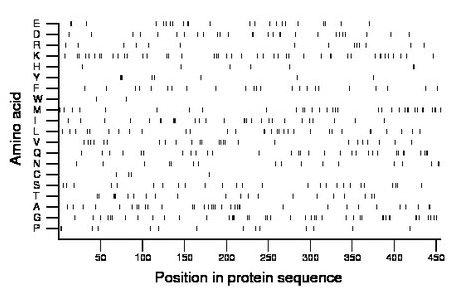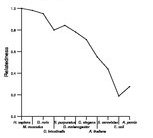
| Name: SRP54 | Sequence: fasta or formatted (455aa) | NCBI GI: 226371618 | |
|
Description: signal recognition particle 54kDa isoform 2
|
Referenced in: ER, Golgi, and the Secretory Pathway
| ||
Other entries for this name:
alt prot [504aa] signal recognition particle 54kDa isoform 1 | |||
|
Composition:

Amino acid Percentage Count Longest homopolymer A alanine 7.5 34 2 C cysteine 0.9 4 1 D aspartate 5.9 27 2 E glutamate 5.1 23 2 F phenylalanine 5.1 23 1 G glycine 9.5 43 3 H histidine 1.5 7 2 I isoleucine 6.2 28 3 K lysine 9.7 44 2 L leucine 6.8 31 2 M methionine 7.3 33 2 N asparagine 3.7 17 2 P proline 3.1 14 2 Q glutamine 6.8 31 2 R arginine 3.1 14 1 S serine 5.7 26 1 T threonine 4.6 21 3 V valine 5.5 25 1 W tryptophan 0.4 2 1 Y tyrosine 1.8 8 3 |
Comparative genomics:
Search single species RefSeq proteins at NCBI
Search summary 
Figure data | ||
Related human proteins:Protein Relative score Description Self-match 1.000 signal recognition particle 54kDa isoform 2 SRP54 0.983 signal recognition particle 54kDa isoform 1 LOC650638 0.339 PREDICTED: similar to signal recognition particle 54... SRPR 0.073 signal recognition particle receptor TAP2 0.010 transporter 2, ATP-binding cassette, sub-family B is... TAP2 0.009 transporter 2, ATP-binding cassette, sub-family B is... TEX9 0.009 testis expressed 9 CREBBP 0.007 CREB binding protein isoform b CREBBP 0.007 CREB binding protein isoform a AK1 0.006 adenylate kinase 1 UPF1 0.006 regulator of nonsense transcripts 1 AKD1 0.005 adenylate kinase domain containing 1 isoform 1 [Hom... AKD1 0.005 adenylate kinase domain containing 1 isoform 2 [Homo...Human BLASTP results (used to prepare the table) | |||
Gene descriptions are from NCBI RefSeq. Search results were obtained with NCBI BLAST and RefSeq entries. When identical proteins are present, the self-match may not be listed first in BLASTP output. In such cases, the table above has been reordered to place it first.
See About the Figures for the scoring system used in the figure above right. The same scoring system was used in the table of BLASTP results.
Guide to the Human Genome
Copyright © 2010 by Stewart Scherer. All rights reserved.
